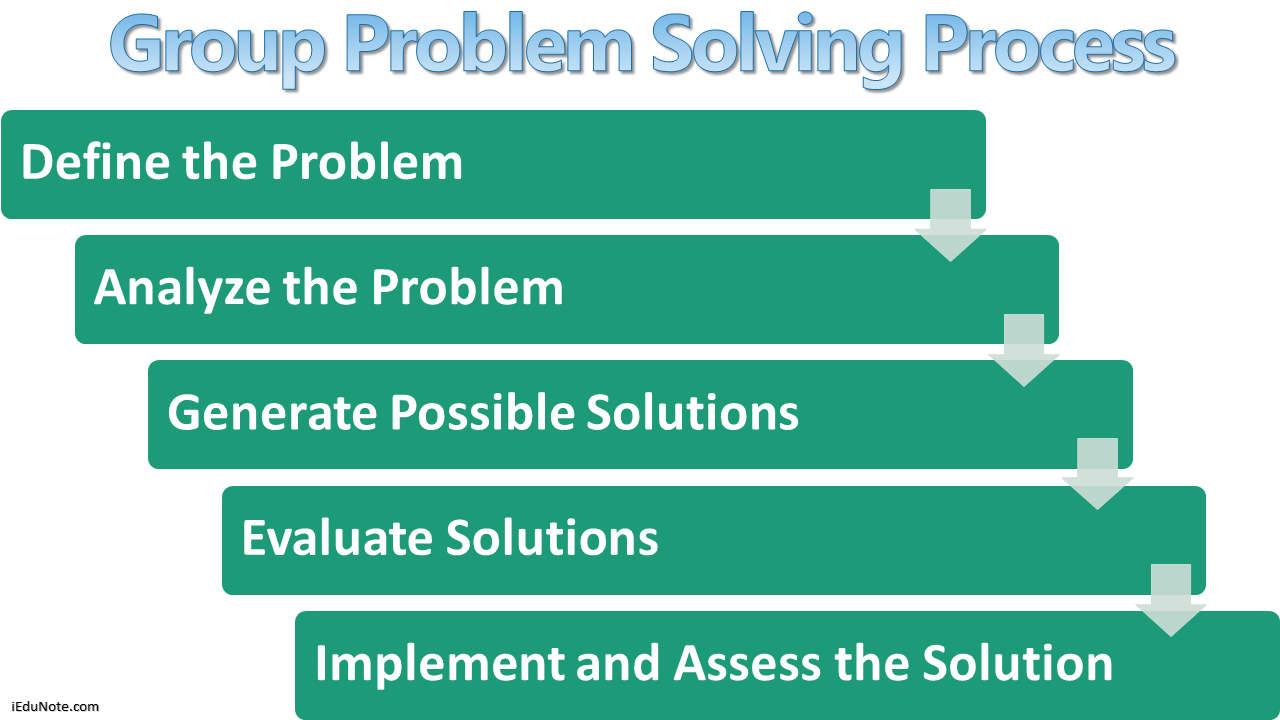Several similar problem-solving models are based on the reflective thinking process. As you read through the steps in the process, think about how you can apply what we learned regarding the general and specific elements of problems.
Some of the following steps are straightforward, and they are things we would logically do when faced with a problem.
Group problem-solving is the process of gathering all expert people, analyzing the problem, finding a solution for it through discussions, and reaching a decision to take action.

5 Steps of Group Problem Solving Process
Step 1: Define the Problem
Define the problem by considering the three elements shared by every problem:
- The current undesirable situation,
- The goal or more desirable situation, and
- Obstacles in the way.
At this stage, group members share what they know about the current situation without proposing solutions or evaluating the information. Here are some good questions to ask during this stage:
- What is the current difficulty?
- How did we come to know that the difficulty exists?
- Who/what is involved?
- Why is it meaningful/urgent/important?
- What have the effects been so far?
- What, if any, elements of the difficulty require clarification?
At the end of this stage, the group should be able to compose a single sentence that summarizes the problem called a problem statement.
Step 2: Analyze the Problem
During this step, a group should analyze the problem and the group’s relationship to the problem.
Whereas the first step involved exploring the “what” related to the problem, this step focuses on the “why.” At this stage, group members can discuss the potential causes of the difficulty.
Group members may also want to begin setting out an agenda or timeline for the group’s problem-solving process, looking forward to the other steps.
Step 3: Generate Possible Solutions
During this step, group members generate possible solutions to the problem. Again, solutions should not be evaluated at this point, only proposed and clarified. The question should be what we could do to address this problem, not what we should do to address it.
It is perfectly OK for a group member to question another person’s idea by asking something like “What do you mean?” or “Could you explain your reasoning more?” Discussions at this stage may reveal a need to return to previous steps to better define or more fully analyze a problem.
Since many problems are multifaceted, group members must generate solutions for each part of the problem separately, making sure to have multiple solutions for each part. Stopping the solution-generating process prematurely can lead to groupthink.
Step 4: Evaluate Solutions
During this step, solutions can be critically evaluated based on their credibility, completeness, and worth.
Once the potential solutions have been narrowed based on more obvious differences in relevance and/or merit, the group should analyze each solution based on its potential effects—especially negative effects.
Groups that are required to report the rationale for their decision or whose decisions may be subject to public scrutiny would be wise to make a set list of criteria for evaluating each solution.
Additionally, solutions can be evaluated based on how well they fit with the group’s charge and the abilities of the group.
Step 5: Implement and Assess the Solution
Implementing the solution requires some advanced planning, and it should not be rushed unless the group is operating under strict time restraints, or delay may lead to some kind of harm.
Although some solutions can be implemented immediately, others may take days, months, or years. As was noted earlier, it may be beneficial for groups to poll those who will be affected by the solution as to their opinion of it or even do a pilot test to observe the solution’s effectiveness and how people react to it.
Before implementation, groups should also determine how and when they would assess the solution’s effectiveness by asking, “How will we know if the solution is working or not?”
Since solution assessment will vary based on whether or not the group is disbanded, groups should also consider the following questions;
- If the group disbands after implementation, who will assess the solution?
- If the solution fails, will the same group reconvene, or will a new group be formed?